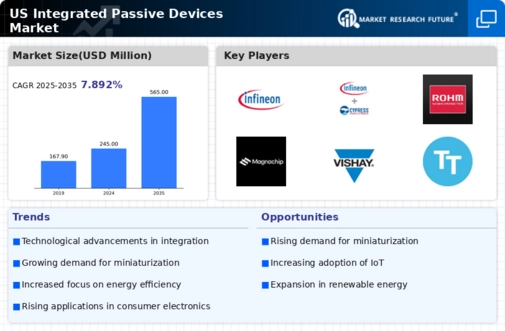The US Integrated Passive Devices Market is characterized by intense competition among various players striving to capture market share through innovation and enhanced product offerings. This market encompasses components that facilitate seamless electronic device operations while minimizing the number of discrete components needed. As the demand for compact and efficient electronics continues to rise, the landscape is shaped not only by technological advancements but also by strategic partnerships, mergers, and acquisitions aimed at fortifying market positions.
Companies are increasingly focusing on developing integrated solutions that cater to various sectors, including automotive, telecommunications, and consumer electronics, leading to a dynamic environment where both established and emerging players continually seek to enhance their competitiveness. Infineon Technologies is a noteworthy participant in the US Integrated Passive Devices Market, leveraging its strong technical expertise and broad product portfolio to maintain a significant market presence. The company focuses on delivering high-performance integrated passive solutions that address the evolving needs of modern electronic systems.
Infineon's strengths lie in its innovative approach to design and manufacturing, allowing for optimized performance and reliability of its devices. The firm has established partnerships and collaborations with key players in various industries, enhancing its exposure in the US market. Additionally, Infineon's commitment to R&D ensures a steady pipeline of next-generation products, positioning the company favorably against competitors and catering to the increasing demand for energy-efficient solutions. Cypress Semiconductor, operating within the US Integrated Passive Devices Market, offers a diverse range of integrated solutions that are vital for various applications.
The company is recognized for its comprehensive product lineup, which includes capacitors, inductors, and other passive components, tailored to meet specific customer requirements. Cypress Semiconductor has established a strong market presence through its focus on high-performance and functionally rich devices that provide users with enhanced operational efficiencies. The firm is notable for its strategic acquisitions aimed at strengthening its technological capabilities and expanding its product offerings in integrated passive devices.
This proactive approach not only reinforces its competitive edge but also positions Cypress Semiconductor as a pivotal player in the market, enabling it to cater effectively to the growing demands of technology-driven sectors in the US.




















